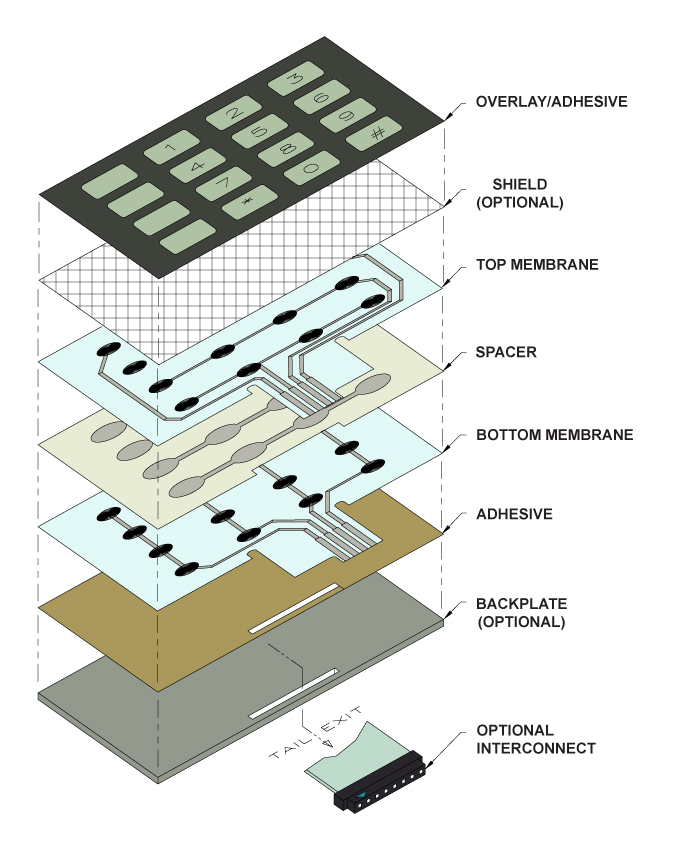The Major Benefits of Using Membrane Switches in Commercial Uses
The Major Benefits of Using Membrane Switches in Commercial Uses
Blog Article
Why Membrane Switches Are Crucial for Durable Control Solution
Membrane layer buttons play a critical role in making sure the resilience and dependability of control systems throughout numerous sectors. As we explore the complex advantages of membrane buttons, it comes to be noticeable that their value transcends mere functionality, affecting user experience and functional efficiency.
Overview of Membrane Buttons
Membrane buttons are versatile and reliable elements typically utilized in numerous digital control systems. The visuals overlay provides both useful and aesthetic layout, while the spacer layer guarantees that the switches are turned on only when pressed.
Membrane switches are commonly favored in applications needing a portable and lightweight style, making them perfect for handheld tools, clinical devices, and commercial equipment. They can be tailored to satisfy details individual requirements and can integrate numerous features such as backlighting, tactile comments, and several shades. Moreover, membrane switches are immune to dust, wetness, and contaminants, making them ideal for settings where sturdiness is vital.
Benefits of Longevity
In several applications, the toughness of membrane switches offers considerable advantages that boost their overall performance and dependability. These switches are developed to hold up against rough settings, making them suitable for use sought after conditions such as high humidity, extreme temperatures, and direct exposure to chemicals. Their robust building and construction assists to avoid damage from physical effect, guaranteeing resilient performance and decreasing the demand for constant replacements.
In addition, membrane layer buttons are resistant to deterioration, which is crucial in applications where constant communication occurs. This sturdiness converts to lower maintenance expenses, as companies benefit from decreased downtime and fewer service disruptions. In addition, the encapsulated design of membrane switches over shields inner components from dust and wetness ingress, additional contributing to their life-span.
Another advantage is their ability to preserve constant performance gradually. With a high resistance for mechanical tension, these switches maintain their responsive responses and electric honesty, ensuring customer fulfillment. Ultimately, the resilience of membrane layer switches over not just enhances functional effectiveness but likewise cultivates confidence in their reliability, making them a preferred option for control systems across various fields.
Applications in Numerous Industries
Long lasting control systems using membrane buttons find extensive applications across a variety of industries, each gaining from the unique features these switches provide. In the clinical sector, membrane switches are critical for gadgets such as patient monitors and diagnostic equipment, where integrity and ease of cleaning are critical. Their resistance to dampness and impurities guarantees they preserve capability in sterile settings.
The automobile industry leverages membrane switches for dashboard controls and infotainment systems, where they offer smooth, low-profile interfaces that improve individual experience. These buttons are likewise created to endure harsh problems, consisting of direct exposure to extreme temperature levels and resonances.
In commercial settings, membrane layer switches are frequently used in machinery control panels, providing responsive responses and durability required for high-usage applications. Their capability to stand up to chemicals makes them ideal for producing settings where spills and contaminants are frequent.

Consumer electronics, such as kitchen appliances and remote controls, additionally make use of membrane switches for their adaptability and cost-effectiveness. Overall, the flexibility and durable nature of membrane switches over make them essential across numerous industries, guaranteeing efficient operation and durability in control systems.
Layout and Visual Charm
While capability is critical, the design and aesthetic charm of control systems equipped with membrane layer buttons play an essential duty in user engagement and total experience (membrane switch). The aesthetic layout of these switches can dramatically affect customer perception and communication. A properly designed membrane layer button boosts the good looks of the gadget, making it more appealing to customers and fostering a connection between the user and the item
Membrane layer changes use a lot of adaptability view it in layout, permitting producers to personalize graphics, shades, and appearances to line up with brand name identification and product visual appeals. The use of dynamic shades and distinctive patterns can attract attention, while responsive feedback can reinforce the user's communication with the tool. In addition, the capacity to integrate LED discover this indications and backlighting right into the membrane switch style gives both functional and aesthetic benefits, boosting visibility and usability in various atmospheres.

Enhancing User Experience

Moreover, membrane switches can be personalized to include visual interfaces, boosting usability by offering information in a clear and intuitive fashion (membrane switch). This modification can consist of icons, tags, and color coding that overview individuals via facility capabilities easily. In addition, their convenience allows for combination in various atmospheres, guaranteeing constant performance whether in commercial equipment or consumer electronics
The resilience of membrane switches also plays an essential duty in user experience. By holding up against harsh conditions and extended usage, these buttons minimize the probability of system failures, therefore advertising reliability and customer self-confidence. Ultimately, the calculated use of membrane changes not just boosts functionality however additionally significantly improves user interaction with control systems, making them an indispensable part in contemporary design.
Final Thought

Report this page